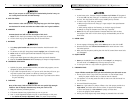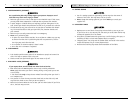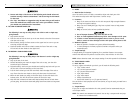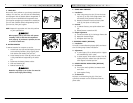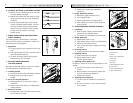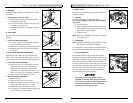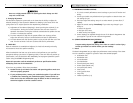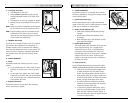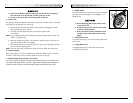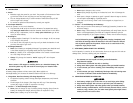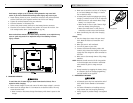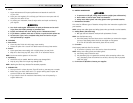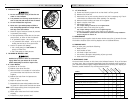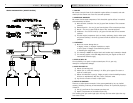
930570 Rev. C
XI. Batteries
41
XI. Batteries
930570 Rev. C
40
• Never expose charger to rain or snow.
• Never unplug charger by pulling on the electrical cord. This will damage the
cord.
• Never open a charger or attempt to repair it yourself. Return charger to Sunrise
or have repairs made only by a qualified person.
• Keep cord out of the way, where it will not be stepped on, tripped over, or
damaged.
3. Caution — To Avoid Damage to the Battery:
• Make sure you use the correct setting for sealed (gel) batteries (located on the
off-board charger).
• Never charge a frozen battery. A fully charged battery will rarely freeze, but the
fluid in a discharged battery can freeze at 16 degrees Fahrenheit (minus 9
degrees Centigrade). If you suspect a battery is frozen, thaw it before charging.
Lead acid batteries generate explosive gas while charging. Completely read
and follow all warnings about the batteries in this user instruction manual
and any labels applied to the product. Failure to do so could result in fire,
explosion, injury and/or death.
C. ACID BURNS (UNSEALED WET CELL BATTERIES)
Acid in batteries is corrosive. It can cause serious burns to the eyes and skin and can
damage floors, furniture, clothing and your wheelchair.
1. Use extreme care not to spill acid when you handle batteries.
Keep batteries upright.
2. Avoid contact of acid with bare skin or clothing.
3. Always wear rubber gloves and safety glasses when you handle batteries.
4. If acid contacts your skin or clothing, wash immediately with soap and
water.
5. If acid contacts your eyes, immediately flood eyes with cold running water
for at least 15 minutes. Seek medical attention immediately.
D. CONNECTING BATTERIES IN BATTERY BOX
1. Each battery weighs up to 55 lbs. Take care to avoid injury when lifting.
2. Keep batteries upright. Take care not to spill acid (wet cell batteries).
3. Always wear rubber gloves and safety glasses when you handle batteries.
4. Before working around batteries, remove all metal personal effects, such as
necklaces, rings, watches, pins, and other metal jewelry that might contact
battery terminal and cause a short.
A. INTRODUCTION
1. Notes:
• Batteries supply the power for your chair. They contain a finite amount of ener-
gy and have limits on how long they can store and supply energy.
• You can charge batteries only a certain number of times before they will fail
and no longer hold a charge.
• For answers to questions about batteries, consult your supplier.
2. Use Proper Batteries:
Your chair operates on two 12 volt batteries.
• They should be 22 NF or Gp 24 size with a minimum of 40 ampere hour rating.
Only deep cycle sealed case construction batteries should be used in this device.
• When you buy a replacement, insist on a deep cycle sealed case type. Do not
use a car starter battery.
3. Breaking In:
• A battery requires “breaking-in” for the first 6 to 12 charges. It will not accept
a full charge for this period.
• It is best to limit the length of your trips until you break the batteries in and
you know the range of your chair.
4. Discharged Batteries:
• Never allow a battery to completely discharge. If you operate your wheelchair until
it has almost stopped, you will greatly reduce the life of your batteries.
• Never let a battery sit in a discharged condition. Give unused or stored batter-
ies a full charge once per month.
• Always fully charge the batteries. Avoid “topping Off” with frequent
charges.
Never connect a life support or auxiliary device to a wheelchair battery. The
electrical system may fail, and result in severe injury to or death of rider.
B. BATTERY CHARGER
A battery charger produces a direct current (DC). When applied to a
discharged battery, this reverses the chemical reaction that led to its discharge.
1. Charge Rate. How fast a battery will charge depends on:
• Its electrical capacity; state of charge; electrolyte temperature, and; internal
condition.
• The DC output of the charger. (The charge rate will vary if the alternating
current (AC) supply is higher or lower than 110 volts).
2. Caution — To Avoid Damage to the Charger:
• Never place the charger on top of a battery during charging. (Gases from the
battery can damage the charger and may lead to an explosion or fire).
• Never place a battery on top of the charger.



